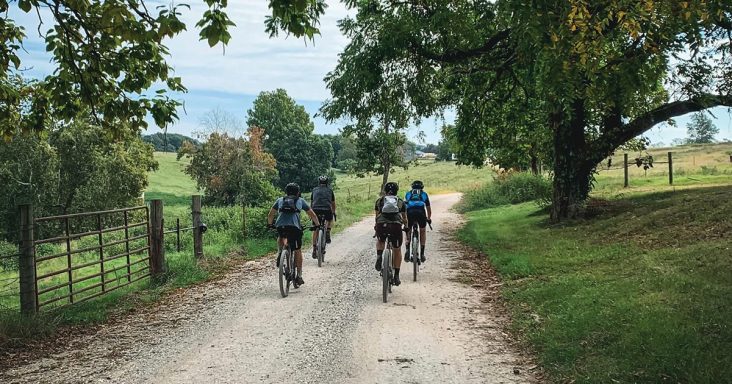Graveler more of ‘an experience,’ could be big for tourism
by June 9, 2024 9:22 pm 466 views

Arkansas has 69,000 miles of unpaved roads, according to the state’s Department of Agriculture, and there are also many more miles of unpaved roads that crisscross national forest lands. They may soon turn into an economic engine fueled by bicycle tourism.
Organizers with the Ozark Foundation hope the Arkansas Graveler will become an annual event. The six-day ride stretches 340 miles from the University of Arkansas campus in Fayetteville to the Arkansas State University campus in Jonesboro.
Scotti Moody, Graveler event director and a former professional cyclist, recently told the Northwest Arkansas Business Journal that the goal is for about 400 cyclists to participate in the 2024 event set for June 23-28. The route will go through Oark, Jasper, Marshall, Mountain View and Cave City. It should be a tourism boon to the rural businesses the cyclist will utilize on the ride. Hotels, restaurants, convenience stores, and other businesses will be exposed to many customers that have likely never visited rural Arkansas, she said.
In addition to the Ozark Foundation, other partners for the event include Arkansas Department of Parks Heritage and Tourism, Arkansas Economic Development Commission, Arkansas Game and Fish Commission, Arkansas State University, University of Arkansas, Experience Fayetteville, Walmart, Arvest Bank and University of Arkansas for Medical Sciences.
“Working to build the Arkansas Graveler has been one of the greatest joys of my cycling career,” Moody said. “After having raced professionally around the world, this is my chance to give back to the sport, the people, and the landscapes that have given me so much. This event ties together many rural communities I’ve ridden through and love, bringing all my training, touring and racing days full circle. I’m excited to reveal how amazing our gravel is, but more so, the homegrown hospitality of Arkansas as we showcase locally sourced cuisine, outdoor recreation, and folksy entertainment you can only find here.”
Gravel biking is a growing business sector. In 2023, it had a $519 million market and is projected to grow about 13.5% each year through 2030, Cognitive Market Research reported. During the past decade and a half, the biking tourism sector has steadily grown, Runway Group Director of Outdoor Recreation and Trail Innovation Gary Vernon said. Mountain and trail biking have always been popular, but the gravel component is relatively new. He said the sport’s popularity has come “out of nowhere” — similar to the pickleball craze. Unlike sports where you have to spend money to build courts and facilities, every single Arkansas community has the one thing they need for this sport — gravel roads.
“It’s really fun to see how mountain biking has been impacting the state for 15 years. Some of the most beautiful places in Arkansas are down gravel roads,” Vernon said.
Many associate tourism biking with Northwest Arkansas, but there are many opportunities to grow the sector in the Ozarks and Delta, Ecological Design Group principal Martin Smith said. A Delta native, Smith said the development of the Crowley’s Ridge trail system would turn into an economic engine for the region. The Ridge stretches for more than 200 miles from the Missouri bootheel down to Helena. Along this route there are almost 200 campsites and five state parks, Smith said.
“It’s very unique. Everyone thinks the Delta is windy and flat. Not on Crowley’s Ridge,” he said. “It’s a fascinating network of connectivity. … It connects to the economic activity of the Delta.”
Grants are being sought to develop the trail system along the Ridge, which is about 10 miles wide at some points. Besides physical development, another problem is promotion and advertising, Smith said. Many people are not aware of what the Ridge already has to offer in terms of outdoor recreation.
“We need to utilize the tools and resources we already have,” he said.
One of the issues that will have to be addressed as the sport’s popularity rises is traffic on the roads. Many motorists in the Natural State are not accustomed to heavy bicycle traffic, especially on rural routes, and it’s a dynamic with which motorists will have to adjust.
In addition to thousands of miles of gravel roads, the state has other advantages. Biking is popular in the western United States, but there is an issue that plagues nearly all those states — cold and snowy winter weather. Arkansas has relatively mild winters and that means it could host tourism cyclists almost year-round, Moody said.
The Graveler will expose many new cyclists to the state, and the goal is to turn it into an advertising and promotions bonanza, Moody said. The hope is that not only will the cyclist who participates come back, but they will promote it within cycling circles through word of mouth.
For those who can’t participate in the full six days, a “mini graveler” will be held during the first day of the event. Bikers can ride along for the first day from Fayetteville to Oark.
Moody said she can’t wait for cyclists to see the small towns and quaint towns along the route. Each cyclist will go at their own pace and hopefully many will come away with fond memories.
“This is not a race, this is an experience,” Moody said.
